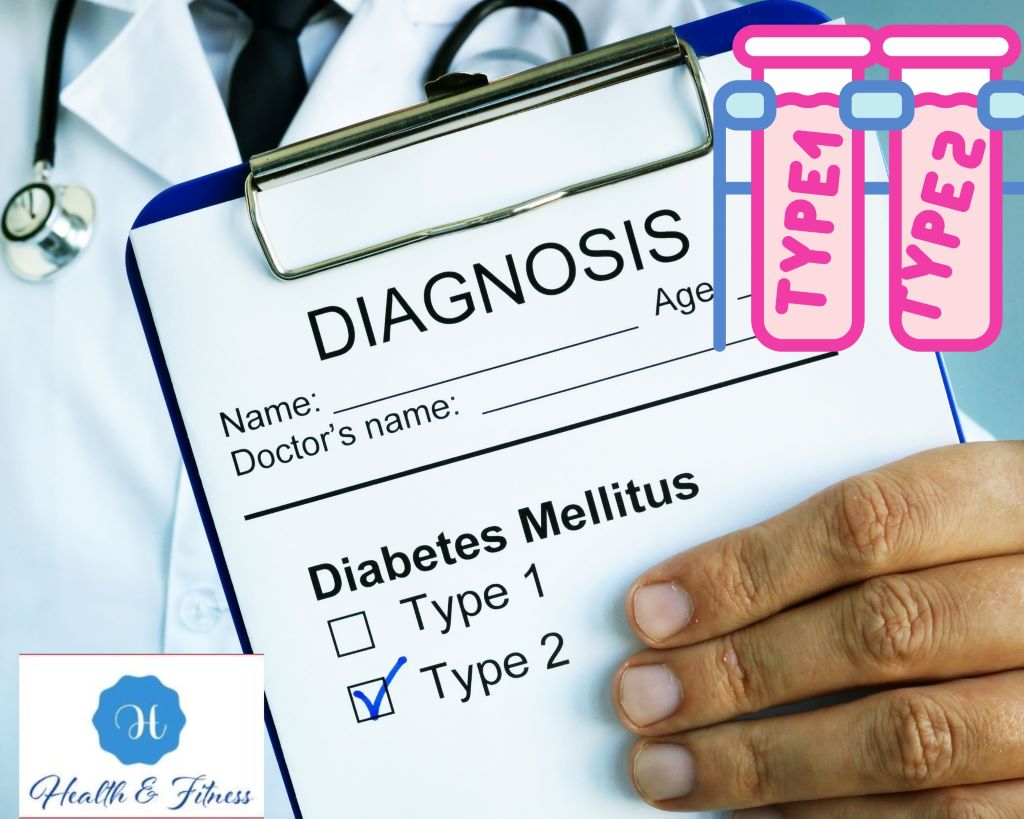Differences between Type 1 Diabetes and Type 2 can be hard to understand, especially when both involve blood sugar issues. The problem is that mixing them up can lead to the wrong treatment or missed warning signs. To fix this, I’m sharing clear, up-to-date facts about what makes Type 1 Diabetes and Type 2 different. This guide uses simple words and real-life insights to help you take charge of your health. Let’s explore and clear up the confusion!
What is Diabetes? A Simple Overview.
Diabetes occurs when the body can’t regulate blood sugar. Glucose from food provides energy for your body. When it’s too high or too low, it can cause problems like tiredness or even heart disease. Diabetes is classified into two primary forms: Type 1 and Type 2. They share some traits, but their causes, symptoms, and treatments are very different. Let’s explore the Differences Between Type 1 diabetes and type 2 to understand them better.
Top Major Differences Between Type 1 and Type 2 Diabetes
Here’s a quick snapshot of each type:
Type 1 Diabetes
The immune system attacks the pancreas, stopping insulin production, requiring daily insulin injections or a pump.
It often starts with kids or young adults, but adults can get it too.
It’s not caused by lifestyle, it’s mostly genetic.
Type 2 Diabetes
Your body might lack sufficient insulin or fail to utilize it properly.
It’s often tied to being overweight, not exercising, or eating poorly.
It occurs more often in adults, but children can develop it as well.
You may manage it with lifestyle changes, pills, or sometimes insulin.
Top Differences Between Type 1 Diabetes and Type 2: What Causes Them?
The Type 1 vs Type 2 symptoms begin with why they happen. Knowing the causes helps you manage or prevent these conditions.
Why Does Type 1 Diabetes Happen?
Type 1 diabetes is an autoimmune condition. The immune system destroys insulin-producing cells, causing sugar to build up in the blood and lead to health problems.
- Genetics: A family history of type 1 diabetes raises your risk.
- I’ve seen families where multiple people have it, and they manage it well with support.
- Triggers: Things like viruses might start an immune system attack, but doctors aren’t sure exactly why.
- Type 1 diabetes isn’t caused by diet or exercise like Type 2.
Why Does Type 2 Diabetes Happen?
Nerve damage can cause tingling or numbness.
Lifestyle plays a big role, but genes matter too.
- Lifestyle Factors: Being overweight, not moving enough, or eating lots of sugary or processed foods raises your risk. I like how simple changes, like walking every day, can help prevent it.
- Genetics: Having close relatives with Type 2 increases your risk. Some groups, like African Americans or Hispanics, have a higher risk.
Age and Other Factors: It’s more common after age 45, but kids are getting it now because of rising obesity rates.
Major Differences in Symptoms Between Type 1 and Type 2 Diabetes.
The Insulin dependency comparison also shows up in their symptoms. Type 1 diabetes symptoms appear fast, whereas Type 2 develops gradually.
Symptoms of Type 1 Diabetes
Type 1 diabetes symptoms appear suddenly, especially in kids and teens.
Here’s what to look for:
- Super Thirsty: You might feel you can’t drink enough water (called polydipsia).
- Peeing a Lot: Your body tries to flush out extra sugar through urine (polyuria).
- Weight loss can occur even with increased eating, as your body struggles to use sugar for energy.
- Feeling Tired: Without sugar in your cells, you feel weak and drained.
- Blurry Vision: High blood sugar may harm vision.
- Fruity Breath: This happens when your body burns fat for energy, making ketones.
- Mood Changes: Kids might get irritable or have trouble focusing.
I’ve seen parents spot these signs in their kids and act quickly, which can be a lifesaver. If you observe this, consult a doctor without delay.
Symptoms of Type 2 Diabetes
Type 1 symptoms come quickly; Type 2 develops slowly.
They include:
- Feeling Tired: You might feel sluggish because your cells aren’t getting energy.
- Peeing Often and Thirsty: Like Type 1, but usually less intense.
- Slow-Healing Cuts: High blood sugar slows your body’s healing.
- Nerve damage can cause tingling or numbness.
- Frequent Infections: Yeast infections might keep coming back.
Type 2 can be hard to spot because it feels like normal aging. I’ve talked to people who ignored these signs until a blood test showed diabetes.
Major Differences Between Type 1 Diabetes and Type 2: Health Risks
Both types of diabetes can cause serious problems if not managed. The Risk factors for diabetes types affect which risks are more common.
Risks of Type 1 Diabetes
Type 1 Diabetes can lead to:
- Low Blood Sugar (Hypoglycemia): Too much insulin or skipping meals can cause shakiness, sweating, or fainting.
- DKA: Without insulin, ketones make your blood acidic.
- This is dangerous if untreated.
- Eye Damage: Elevated blood sugar can damage eye vessels, potentially causing vision problems (diabetic retinopathy).
- Nerve damage can cause pain or tingling in the hands and feet.
- Kidney Issues: Over time, diabetes may result in kidney failure.
I’ve seen how scary DKA can be, but regular insulin and doctor visits can prevent it.
Risks of Type 2 Diabetes
Type 2 Diabetes has similar risks but also unique ones:
- Heart Disease: Type 2 raises your risk of heart attacks and strokes.
- High Blood Pressure: This is common and can harm your heart and kidneys.
- High Cholesterol: Bad cholesterol levels can clog arteries.
- Foot problems: Poor blood flow and nerves can cause ulcers.
I like how eating healthier and exercising can lower these risks a lot.
Top Differences Between Type 1 Diabetes and Type 2: How Are They Treated?
The Differences Between Type 1 diabetes and type 2 are clear in their treatments. Type 1 Diabetes always needs insulin, while Type 2 often starts with lifestyle changes.
Treating Type 1 Diabetes
Since Type 1 diabetes means no insulin production, treatment focuses on replacing it:
- Insulin Therapy: You need insulin through injections or a pump. There are fast-acting and long-acting types to keep blood sugar stable.
- Blood Sugar Checks: You test your levels several times a day with a glucometer or continuous glucose monitor (CGM).
- Healthy Habits: Eating well and staying active help, but they don’t replace insulin.
Education: Learning about type 1 diabetes helps you manage it. I’ve seen people live full lives by staying informed and working with doctors.
Treating Type 2 Diabetes
Type 2 Diabetes treatment depends on how severe it is:
Lifestyle Changes: Eating healthier, losing weight, and exercising can improve insulin use. I’ve tested meal plans with veggies and whole grains, and they work well.
- Medications: Metformin helps improve insulin use.
- Some need injections, like GLP-1 agonists.
- Insulin: Used when other treatments aren’t enough.
- Monitoring: Regular blood sugar checks keep you on track.
Top Differences Between Type 1 Diabetes and Type 2: Can You Prevent Them?
Prevention is another area where the Differences Between Type 1 diabetes and type 2 stand out.
Preventing Type 1 Diabetes
Since Type 1 diabetes is autoimmune and genetic, you can’t stop it. But you can:
- Watch for Symptoms: Spotting signs early prevents serious issues like DKA.
- Get Genetic Counselling: If Type 1 Diabetes is in your family, counselling can help you understand risks.
- Stay Educated: Knowing the symptoms helps you act fast.
I’ve seen families catch type 1 diabetes early, and it made a vast difference.
Preventing Type 2 Diabetes
Type 2 diabetes is often preventable with lifestyle changes:
- Eat well: Pick fruits, veggies, grains, and lean protein.
- Cut back on sugar and junk food.
- Stay Active: Aim for 150 minutes of exercise a week, like walking or biking.
- Healthy weight: Losing 5–10% can cut your risk.
- Get Screened: Blood tests can catch prediabetes before it becomes Type 2.
I like how these steps not only prevent diabetes but also boost your energy.
FAQS About Differences Between Type 1 Diabetes and Type 2
What is the major difference between diabetes 1 and 2?
Type 1 Diabetes is an autoimmune condition where the body stops making insulin, so you need insulin therapy. Type 2 Diabetes is when the body doesn’t use insulin well or makes enough, often managed with lifestyle changes or pills.
How do type 2 diabetes symptoms differ from type 1 diabetes symptoms?
Type 1 Diabetes symptoms hit fast and include extreme thirst, frequent urination, weight loss, and fruity breath. Type 2 Diabetes symptoms are slower, like tiredness, slow-healing cuts, and numbness in the hands or feet.
How can you tell type 1 diabetes from type 2?
Doctors use blood tests like A1C, fasting glucose, or autoantibody tests. Type 1 Diabetes often starts in kids and needs insulin right away. Type 2 is more common among adults and may not need insulin at first.
Does type 2 diabetes need insulin?
Not always. Many people with type 2 diabetes manage it with diet, exercise, and pills. But if blood sugar stays high, insulin might be needed.
Conclusion: Take Charge of Your Health
Understanding the Differences Between Type 1 diabetes and type 2 is the first step to managing or preventing these conditions. Type 1 Diabetes requires lifelong insulin and careful monitoring, but people live active, happy lives with the right tools.
Type 2 Diabetes is often preventable with healthy habits, and even if you have it, minor changes can make a big difference. I’ve seen people transform their lives by eating better or walking daily. Consult your doctor, get tested, stay aware. You can do this!
Reference
American Diabetes Association: https://www.diabetes.org/



